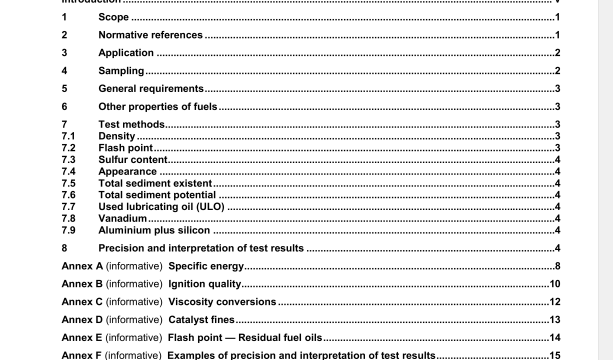ISO 8217 pdf download – Petroleum products一Fuels (class F)一 Specifications of marine fuels.
7.3 Sulfur content
The reference method for compliance with this International Standard shall be ISO 8754. In some geographical areas, other methods may be specified by national authorities for environmental control purposes.
In the event & a dispute conceming sulfur content, all parties should agree, pflor to testing, upon the same sulfur certified reference material
7.4 Appearance
For categories DMX, DMA and DUB, the appearance of samples shall be assessed by visual inspection in good light, free from glare and shadow, at a temperature between 10 ‘C and 25 ‘C.
— DMX and DMA categories samples shall appear clear and bnghi
— If the clarity of DMB category samples affords visual inspection, and if they appear free from visiole sediment and water, testing for total sediment existent and for water is not required.
7.5 Total sediment existent
The total sediment existent shall be determined in accordance with ISO 10307-1 for all DMB category
samples that fail the visual inspection prescribed in 7.4.
7.6 Total sediment potential
The method given in ISO 10307-2 for determination of potential sediment Procedure A) shall be the reference method.
7.7 Used lubricating oil (ULO)
The reference test method for compliance with this International Standard shall be IP 501.
7.8 VanadIum
The reference test method for corripliance with this International Standard shall be ISO 14597.
7.9 AluminIum plus silicon
The reference test method for compliance with this International Standard shall be ISO 10478.
8 Precision and interpretation of test results
The test methods specified in Table 1 and Table 2 all contain a statement of precision (repeatability and reproducibility). Attention is drawn to ISO 4259:1992. Clause 9 and Clause 10, which cover the use of precision data in the interpretation of test results; this method shall be used in cases of dispute. Information about precision and interpretation of test results is also given in Annex F.
Marine fuel quality complaints can be categorized generally as either those where a problem has occurred on board or where there Is a dispute over the acceptability of the product pna to its use Whichever the case, the fuel must be tested to ascertain its nature
F.2 Use of ISO 4259
Table 1 and Table 2 of this International Standerd, specify maximum and minimum limits to the true value of a given property True value, as defined by ISO 4259. represents the average of an mflnlte number of single results obtained by an infinite number of laboratories. Therefore this true value can never be established exactly. A fuel test, run a number of times at the same laboratory, by the same person. on the same sample, under the same conditions, wil rarely ield exactly the same answer for each test run. Occasional human mistelces or omissions will introduce a random error, which can be quantified for each test method as Repeatability (4. When two different laboratories test the same sample using the same method, the randoe’n error is called Reproducibility (R)
ClauseS of this International Standard states:
‘The test methods specified In Table 1 and Table 2 all contain a statement of precision (repeatability and reproducibility) Attention is drawn to ISO 4259:1992. Clause 9 and Clause 10, which cover the use of precision data in the interpretation of test results: it is this method that shall be used in cases & disoute,’ (Emphasis added).
1S04259:1992, Clause 9, provIdes information to allow the supplier or the recipient of fuels to judge the quality of a product with regard to the specification when a single restit is avadat,le.
F.3 Recipient with a single test result
A recipient who has no other Information on the true value of a characteristic.
ISO 8217 pdf download – Petroleum products一Fuels (class F)一 Specifications of marine fuels
